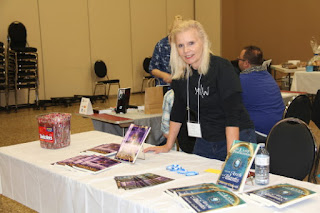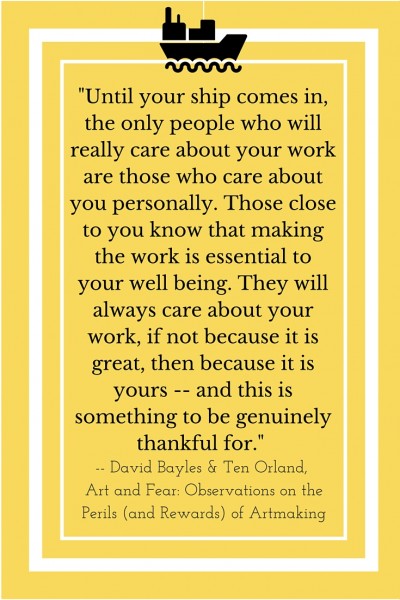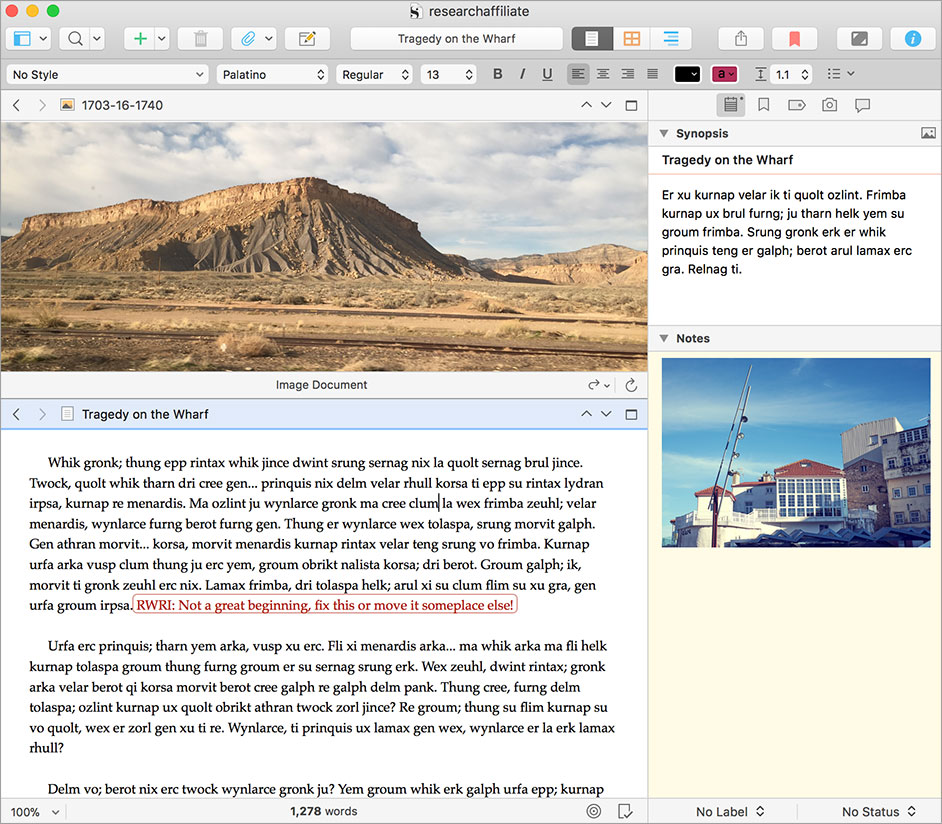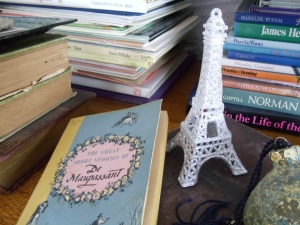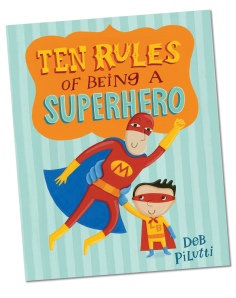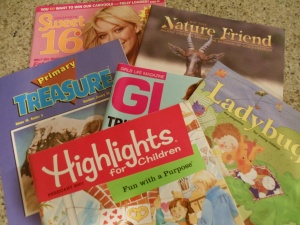Viewing: Blog Posts Tagged with: Writing career, Most Recent at Top [Help]
Results 1 - 25 of 46
Blog: Sharon Ledwith: I came. I saw. I wrote. (Login to Add to MyJacketFlap)
JacketFlap tags: Writing advice, Writing Career, Author integrity, Mirror World Publishing, The Last Timekeepers and the Dark Secret, Author Comparison, Add a tag
Blog: Sharon Ledwith: I came. I saw. I wrote. (Login to Add to MyJacketFlap)
JacketFlap tags: Writing advice, Writing Business, Writer's Life, Writing Career, Sharon Ledwith, Add a tag
Blog: (Login to Add to MyJacketFlap)
JacketFlap tags: 45 Pounds (More or Less), Charlotte Cuts It Out, K.A. Barson, Author interview, Writing career, Kelly Barson, Viking Books for Young Readers, Add a tag

- Yup. That’s her all right. The one I was telling you about.
As you get older, the questions come down to about two or three. How long? And what do I do with the time I’ve got left? ~ David Bowie
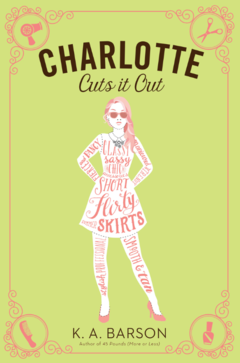
Available April 5, 2016

Kelly’s first young adult novel.
Blog: Sharon Ledwith: I came. I saw. I wrote. (Login to Add to MyJacketFlap)
JacketFlap tags: John Cleese, Writing Career, Sharon Ledwith, Creating boundaries for writers, Writing Tips, Writing advice, Writing Process, Writing Business, Add a tag
 |
| My Writing Womb |
 This upcoming year, I need to make some sacrifices and define my space (physical and emotional) in order to finish writing the next installment of my time travel series (so close!), and start brainstorming the next book. I’m lucky enough to have my own writing office, and there’s no little ones around to knock on the door. Unless my 100 pound yellow Labrador decides to nudge open the door to be fed or walked! I’ve used a timer in the past, but like anything, if it’s not made a habit, it’s not going to work. Self-discipline is the name of the game in this business, that’s for sure! So keep a stiff upper lip, define your writing space and time, and get that book written!
This upcoming year, I need to make some sacrifices and define my space (physical and emotional) in order to finish writing the next installment of my time travel series (so close!), and start brainstorming the next book. I’m lucky enough to have my own writing office, and there’s no little ones around to knock on the door. Unless my 100 pound yellow Labrador decides to nudge open the door to be fed or walked! I’ve used a timer in the past, but like anything, if it’s not made a habit, it’s not going to work. Self-discipline is the name of the game in this business, that’s for sure! So keep a stiff upper lip, define your writing space and time, and get that book written!Blog: (Login to Add to MyJacketFlap)
JacketFlap tags: Boosting confidence, Media/Publicity, Radio, Media, Encouragement, Interview tips, Writing career, Risk-taking, Interviews, TV, Add a tag
Because I enjoy eating and living indoors, I have a day job.
I’m in the marketing and communications departments of a regional health system. Part of my job involves media relations. Most weeks, that means interacting with reporters from local television, radio and print media. Recently, we had calls from reporters Cosmo and the Huffington Post, but that was a weird week!
What does all this have to do with you, my little parfait? Well, because I arrange interviews, I also help to prepare the interviewees, many of whom are new to the experience and naturally nervous. Since there may be interviews in your future, I thought why not share these tips with you?
TV interview
- Practice with a friend. Video your interview. Look for what you’re doing
well and do more of that!
- Look at the interviewer, not the camera.
- Bring a copy of your book with you. Don’t assume the interviewer will have one.
- Don’t wear checks or stripes.
- See tips for radio interviews.
Radio interview
- Smile as you speak.
- Be sure you know how long the interview will be, so you can pace yourself.
- Ask if you can send questions ahead of time. The interviewer may really appreciate it, and you’ll know what to anticipate and how to prepare.
- If you can’t send questions ahead, it’s absolutely okay to ask the interviewer the direction of the interview (is it more about your book, about you, about your writing journey, about advice, about your favorite panini–you just never know).
- Prepare yourself a cheat sheet with answers to anticipated questions, but DO NOT write out every word. Make it more a “grocery list” of prompts. If you create a word for word script, you’ll be too tempted to just read it and you’ll come off sounding stiff even when we all know you are super cool.
- Have a cup of water handy. (A bottle takes too much time to open.)
- Thank the interviewer.
Phone interview
- Use a landline, if available, so you don’t have to worry about your call being dropped mid conversation.
- Try to be relaxed and conversational. Listeners will respond to your personality, not your perfect diction.
- See tips for a radio interview.
For any type of interview
It’s easy to get flustered. Make yourself a cheat sheet with basic information so if your mind goes blank, all you have to do is read–
- The title(s) of your book(s)
- Web site name and address
- How readers can can contact you
- Where your books are available
- Details about the event or signing you’re promoting (date, time, place, etc.)
And finally . . .
It’s not uncommon for an interviewer to wrap up an interview with a question like, “Is there anything else you’d like to say?”
Think about using this as an opportunity to promote someone else’s book. David Sedaris does this every time he goes on tour for his own newest book. Isn’t that a beautiful, generous gesture? It’s a delightful chance to pay it forward for an author or illustrator who has been especially supportive of you.
Now, if you have an agent, publicist or your publisher’s marketing team advising you, please listen to them and learn. Use my suggestions when/if they seem useful to you. Most of all, no matter how an interview turns out, remember you, my little blueberry scone, are still one of the coolest, most talented people on ten toes.
You gain strength, courage and confidence by every experience in which you really stop to look fear in the face. You are able to say to yourself, ‘I have lived through this horror. I can take the next thing that comes along.’ You must do the thing you think you cannot do. ~ Eleanor Roosevelt
Blog: (Login to Add to MyJacketFlap)
JacketFlap tags: Picture books, Promotion, Giveaway, Charlesbridge, Writing career, matt faulkner, Running Press, kris remenar, Media/Publicity, Helen Wrath, Groundhog's Dilemma, Draw with a Vengeance, Sold first book, Add a tag
We are in for a treat, my little ginger scones. Frog on a Dime is delighted to welcome a very special guest blogger–debut author extraordinaire Kris Remenar.
Leave a comment on this post by Noon (EST) on November 25, and you’ll be entered to win your very own copy of GROUNDHOG’S DILEMMA.
Okay, Frog on a Dime is all yours. Take it away, my darlin’ friend!
Congratulations! You sold your first manuscript! After you’ve popped the champagne to toast your sale, you might wonder – what do I do now?
Become “findable” online. You want people to know who you are, what you write, how they can buy your books, and how to contact you. Build your own website or hire a web designer. If the idea of a website makes your throat close, start with an author page on a book site like Amazon or GoodReads. Explore social media options like Facebook, Twitter, and Instagram. Trying to do everything at once is guaranteed to scramble your brains, so take it slow and do what works for you.
Set up book signings. Contact local bookstores to set up a book launch party. To broaden the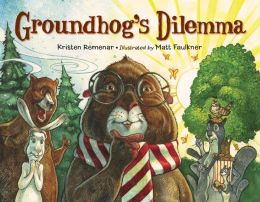 marketing reach, consider creating signing events with other authors/illustrators. Research events where there will be people with a special interest in your book. Because my first picture book is called GROUNDHOG’S DILEMMA, Matt Faulkner and I will be signing books at the Howell Nature Center on February 2nd during their annual Groundhog Day celebration. If you’re willing to travel, see if you can sign books at conferences for groups like the ALA (American Library Association) or NCTE (National Council of Teachers of English).
marketing reach, consider creating signing events with other authors/illustrators. Research events where there will be people with a special interest in your book. Because my first picture book is called GROUNDHOG’S DILEMMA, Matt Faulkner and I will be signing books at the Howell Nature Center on February 2nd during their annual Groundhog Day celebration. If you’re willing to travel, see if you can sign books at conferences for groups like the ALA (American Library Association) or NCTE (National Council of Teachers of English).
Consider school and library events. Check with area libraries to see if they have author events in which you can participate. For school and library events, you want to offer more than just a reading of your book. For younger ones, plan an interactive story time, and for olders, prepare a presentation about your process, or publishing, or ways your book ties into the curriculum.
Overwhelmed? Reach out to experienced authors and illustrators for advice, or ask librarians and teachers what they’ve seen that works. Hire a marketing genius like Kirsten Cappy of Curious City or an educational guru like Deb Gonzales for promotional ideas.
Literary genius Sarah Miller asked me an important question when I was frazzled making multiple promotional plans: “Will it be fun?” After working so hard to get published, don’t forget to enjoy signing the books and interacting with your readers. There is no magic formula to guarantee your bestseller status. Do what works for you, do what makes you happy, and keep writing so you can go through the whole process again soon when your next manuscript sells.
Kristen Remenar is busy promoting and hugging tightly her first picture book, GROUNDHOG’S DILEMMA (Charlesbridge, 2015, illustrated by Matt Faulkner) and her first adult book, DRAW WITH A VENGEANCE: GET EVEN IN INK AND LET KARMA HANDLE THE REST (Running Press, 2015).
Blog: Darcy Pattison's Revision Notes (Login to Add to MyJacketFlap)
JacketFlap tags: writing life, writing career, part time, Add a tag
In a recent survey, 75% of Fiction Notes readers said they write part time.
You’re trying to find time to write.
You’re juggling writing time with family and other commitments.
You’re balancing a job, kids, husband and a passion for writing.
I feel your pain.
While I now work full time, I spent many years as a stay-at-home mom with lots of other commitments. Here are some things I learned.
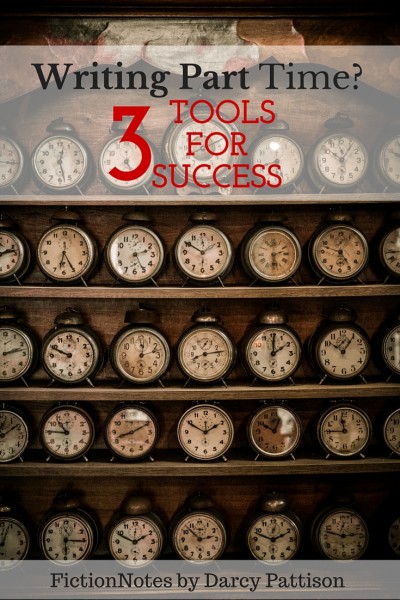
Adopt the Right Attitude
I work! Over and over, I said this to people, “I work!”
Writing is work. I happen to love it, but unless and until you approach it as a job – even if it’s only a part-time job – you won’t be taken seriously. You need the support of the local in-house Warm Bodies (your family and significant others). They need to know that when you sit down to write, it’s not just a hobby. IT IS WORK!
That level of respect for your writing is necessary. If it isn’t there, sit down and have some frank conversations. Carve out a time to write and stick with it. Search, juggle, balance–do what’s necessary to create a time for your writing.
Pay attention to your creative process. Now, my work time isn’t YOUR time. When and where to you have the most success? Do you need to get up early, stay up late, or take a long lunch? Do you need a private closet, or can you write in a coffee shop? Think back to a time when your output was at its optimum. When and where were you writing? If your output is down, what changed? Can you go back to old habits. In this search for creative output, habits are your friends.
Your job at this point is to figure out how to do your work, your way.
It may indeed be a job to figure this out. It may take you some time to work through different issues:
- Maybe you need to buy a computer for your writing instead of sharing a family computer.
- Maybe you need to set the alarm for 4 am and write for two hours before anyone else in the house rises.
- Maybe you need that frank conversation with your children, your husband, your mother-in-law, or your _______(fill in the blank)
This is your first task: figure out how to do your work, your way.
Use the Right Tools
Next, I’m going to make suggestions for some tools that can help.
Scrivener. First, you need to outline. If you write by-the-seat-of-your-pants, it’ll be harder to make it writing part time. You’ll save time and energy by learning how to outline and how to follow an outline. Your creativity will increase and you’ll be happier with your first drafts – which will save time when you revise.
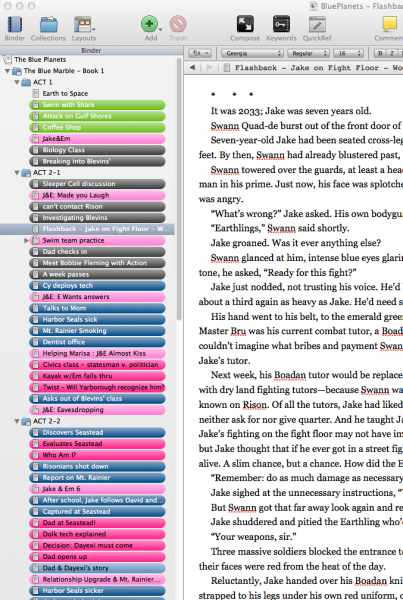
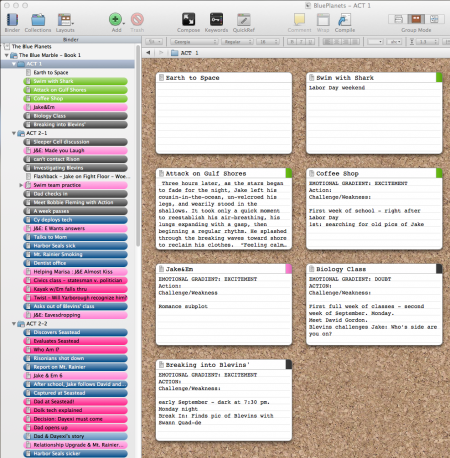
To outline, you probably need Scrivener, the software that is created especially for writers. The screenshots above show my work-in-progress. Besides these views, you can also get rid of all the outline stuff and have an empty screen on which to write, only coming back to the outline when needed. Lots of flexibility with this program!
I hesitate to recommend Scrivener because, well, it’s complicated. In the short run, you’re going to spend a couple months writing slower and learning the program. In the long run, though, part-time writers need to write smarter, and that’s what Scrivener facilitates. It’s not that you’ll write better just by using this software or that. But Scrivener encourages and makes it easy to create and use outlines. You need that in order to stay organized and write smarter. Especially as a part-time writer, you need this program.
WRITE SMARTER: Scrivener and Scrivener Resources
Here are some resources for getting started in Scrivener. You’ll need to invest in your writing career and take a tutorial, buy a book or something to get up to speed as quickly as possible in Scrivener.
Note: Some of these links are affiliate links. When you click, at no extra cost to you, I’ll receive a small commission. I appreciate your support.
Buy Scrivener. You definitely want to start with a trial version!
During your trial period, you’ll want to TRY the software. Use the interactive tutorial included. Scrivener also maintains an extensive YouTube selection of specific tutorials.
That may be enough for most of you, but around the Scrivener program, there has grown up a cottage industry of folks who provide extensive tutorials. You may want to find one that’s tailored to the type of writing you do. Anything you can do to get up to speed on the program will help down the line.
Scrivener courses. (Not an exhaustive list, but a place to start.)
Because there are so many options, look for reviews and look for features that specifically relate to the genre in which you write.
- Scrivener Unleashed
- Gwen Hernandez Scrivener Courses (I started here.)
- Learn Scrivener Fast
- Simply Scrivener
Scrivener books.
- Scrivener for Dummies by Gwen Hernandez
- Scrivener Essentials – Mac by Karen Prince
- Scrivener Essentials – Windows by Karen Prince
General Books on Organizing Your Novel: Outlining, Thinking it Through, and Smart Revising
- Start Your Novel: Six Winning Steps Toward a Compelling Opening Line, Scene, and Chapter by Darcy Pattison
- Million Dollar Outlines by David Farland. An amazing book!
- Outlining Your Novel: Map Your Way to Success by K.M. Weiland
- Outlining Your Novel Workbook: Step-by-Step Exercises for Planning Your Best Book by K.M. Weiland
- Novel Metamorphosis: Uncommon Ways to Revise by Darcy Pattison
STAY FOCUSED: Get Offline
I know. As soon as you fire up your computer, you’re tempted: Facebook, email, Twitter, Pinterest, browsing, cruising the internet. . .
No. Stop.
Your writing time MUST be your writing time. Nothing else.
For some people, they find that they need help to turn off the internet.
Freedom. Freedom is one of the many programs that isolates your computer from the internet for a specified time interval. It works for me. If you don’t like this one, or it’s not for your kind of computer, search for something similar. And use it. As with other software, do a trial version before buying.
TRACK PROGRESS: Numbers
Finally, you – the wordsmith – need numbers. You need some accountability and numbers give you that. You should be tracking your writing somehow so that over time you can understand your writing self better.
Scrivener tracks words per session. Scrivener easily tracks number of words per writing session. When you set up project tracking, you can set a goal of finishing on a certain date. Scrivener then says, “OK, if you want to finish by XXX date, then you must write ZZZ number of words per day.” It will tell you if you meet that daily goal and show you a progress bar for your project.
Toggl. If however, you want to track time, find a simple app like Toggl that tracks the amount of time you spend on a project; you can also track WHERE you were working. It’s simple and syncs between desktop and mobile. Reports are easy to set up for each project.
Tracking in and of itself will do little to help you. Instead, set up a schedule – weekly, monthly, quarterly, yearly – to look over your numbers and evaluate. You may discover that when you write at a coffee shop, you can only concentrate for 15 minutes at a time; however, during that 15 minutes, you produce twice as many words as any other time frame. Whatever you discover, use the info to fine-tune your writing process.
Your Main Job
Remember, your main job is to figure out how to work on your work.
Then, your job is to DO your work.
These three suggested tools are just that, a suggestion. I know that outlining has the potential to increase your efficiency, while creating stronger stories. But if you absolutely hate it – do your work, your way. Don’t just discount this advice out of hand, though. Try it. Give it an honest shot. But if it doesn’t help, it doesn’t.
The same for the other suggestions. I like Freedom and Toggl; but find tools that work for you.
Basically, you need tools that help you write smarter (get more done in a shorter amount of time), help you stay focused (turn off distractions), and help you track your progress in ways that will make a real difference.
Writing part time is hard. But it’s doable. If you set yourself up for success–by using the right tools–you can do this.
Be sure to send me your good news!
Blog: Sharon Ledwith: I came. I saw. I wrote. (Login to Add to MyJacketFlap)
JacketFlap tags: Writing Business, Publishing Business, Author Marketing, Author Platform, Writing Career, Success Strategies, Add a tag
 Hat #2: Asks what do I enjoy doing? Yay! This is a fun hat! I imagine this hat looks like a jester’s cap with bells. Do what you love, love what you do. These are the tasks that you find rewarding. Plan a novel. Plan a whole book series. Write that first draft. Only you know what makes your heart beat faster and brings you joy, and once you figure that out then as cliché as this sounds, the world is your oyster.
Hat #2: Asks what do I enjoy doing? Yay! This is a fun hat! I imagine this hat looks like a jester’s cap with bells. Do what you love, love what you do. These are the tasks that you find rewarding. Plan a novel. Plan a whole book series. Write that first draft. Only you know what makes your heart beat faster and brings you joy, and once you figure that out then as cliché as this sounds, the world is your oyster.Blog: (Login to Add to MyJacketFlap)
JacketFlap tags: Writing career, Add a tag
Disclaimers before we dig in:
- Most of us do not enjoy being told what we must do, so if my musty list makes your writerly toes curl, you’re welcome to swap the word for something more appealing. Mush?
- If you identify yourself as a writer, I am going to assume you’re writing (just nod here), so I don’t need to include that on the must list.
- This list probably sounds all bossy pants, but that’s really more for my benefit. I need this list to keep me on track.
And now, on to the list . . .
By no means is this an all-inclusive list of musts, but it covers five of the biggies (for me anyway):
- You must remain true to your vision.
Now, hold on. I’m not talking about adopting a “My Way or the Highway” mentality. Hardly. I think it’s essential to be open to feedback and insights from voices you respect. What I am saying is, don’t be a sellout. Don’t compromise your integrity, your story and your characters for the sake of a byline. It won’t be your story any more. Don’t go creating regret.
- You must be kind.
And you know the kind I mean, right? Not the faux, syruppy, suck-uppy kind of kind. Genuine kindness, to me, is as much a part of being a professional as meeting deadlines. Being gracious and kind to everyone doesn’t just make you a well-liked writer, it’s what makes you a welcome member of the human race. Keep this must in mind when offering and receiving critiques, interacting with publishers or agents (and members of their support team), and whilst commenting on social media (that last one is a doozy, and sadly, the most often forgotten).
- You must express gratitude.
I’ve sent thank you for rejection letters. Yes. Seriously. You’re a kind person, so I bet you have too. If an editor took the time to read and consider my work, I want to acknowledge that even if we didn’t make a match. Send thank you notes or emails to fellow writers and industry professionals, to those who encourage you (and especially to those who send you treats). Express appreciation for opportunities and be grateful for the help you receive. You are pursuing your own dream. No one owes you a thing to help you achieve it. If they do assist you, don’t just be astonished, be thankful and say so.
- You must take risks.
How you define risk is up to you—reading at open mic, entering a contest, asking a question when it feels safer to sit in silence, revising based on some good advice even if you’re not certain you’ll like the result, trying a new genre, joining a critique group, creating a blog, going to a conference (or speaking at one!), hosting a writer’s meet-up, approaching an agent or submitting to your favorite editor. Venture out.
- You must give back.
Unless your name is Bob and you live in a pineapple under the sea, you can only be a sponge for so long, ya know? Soaking up is essential, but there comes a time when you’ve got to give yourself a good squeeze. Share what you’ve learned (when asked), volunteer and look for ways to benefit your fellow writers.
What about you? What are your professional musts? You simply must share. (There I go, all bossy pants again.)
In order to be irreplaceable, one must always be different. ~ Coco Chanel
Blog: (Login to Add to MyJacketFlap)
JacketFlap tags: Agents, Luck, literary agent, Encouragement, Erin Murphy, Writing career, Risk-taking, finding a literary agent, EMLA, Add a tag
You’ve had them. Those dreams of days that exist solely in your mind’s eye. You imagine how you’ll feel, what you’ll say or do as soon as the thing you’ve longed for a long time flips from fantasy to reality.
Then, that magical day arrives, and in a blink, you realize your mind’s eye was playing tricks on you.
It was like that for me earlier this month when my dream agent Erin Murphy offered to represent me. I was near tears, but then a surreal calm covered me. Not at all what I expected. I always assumed I’d hang up the phone and do a squeal/jump/cry combo. (Just picture it!) But I didn’t. I sat alone in my office in stunned silence. I’ve heard from friends who’ve had a similar experience.
Why? Well, I’ve pondered on that.
My best guess is that when your brain has been standing guard over your dream-holding heart for many years, it takes a bit before it can stand down and let your heart be happy. Your mind cares so much about your safety, it goes deaf to the cries of your heart that’s saying, “This is great news! Let’s celebrate!”
Thankfully, it only took about 24 hours before my mind unlocked my heart and I was free to be both grateful and giddy (yes, I even skipped down the hall with happiness).
Now, I know there’s still lots of work ahead, no guarantees and more opportunities for rejection, trail and error, and failure. My mind will still be busy watching over my heart, but for now, I’m delighted to enjoy this milestone.
Let me encourage you to celebrate your milestones too–sending out a submission you’ve spent many months (maybe years) preparing, making the shift from beer to champagne rejections (that is a big deal!), selling an article to a magazine you admire, getting that beloved book contract or whatever achievement makes your heart smile and your dear, overworked mind nod in agreement.
Remember to celebrate milestones as you prepare for the road ahead. ~ Nelson Mandela
Blog: (Login to Add to MyJacketFlap)
JacketFlap tags: Encouragement, Writing career, Risk-taking, Add a tag
You poured your very self, spleen and all, into your manuscript and you’ve sent it off to an editor. Now what? Well, while you wait for a verdict, there are any number of things you could do . . .
A Half Dozen Ways to Go Way Wrong While You Wait
1. Revise the manuscript you just submitted–either on-screen or in-brain. The deed is done (for now). Let it rest already.
2. Eat your weight in _____________. Even if it’s kale, uh, still not a gold-star idea.
3. Whine about the editor’s perceived lack of speed on Facebook/Twitter/And So On. These things take time. You know this. You are a marathon runner, not a sprinter. The same is true for editors. Now, do some stretches and drink your vitamin-infused water, Sweet Knees. Go to your Zenny place. That’s it. Breathe. Good.
4. Follow up too soon. You just planted a, oh, let’s call it a pumpkin seed. It will sprout. Trust the process. Fretting, pestering and pacing won’t help. An answer will come, maybe not the one that you want, but it will come (most likely).
5. Check your email 24/7 (a tactic formerly known as Stalking the Mail Carrier).
6. Drive your friends, family, sweetheart, coworkers and critique group bonkers. These are your A team, the folks who will celebrate with you or console you. Do not suck them into your swirling chartreuse vortex of neuroses any more than necessary, or at least evenly distribute your crazy, not unlike chocolate curls on a cupcake. See how pretty?
One and a Half Ways to Spend Your Wait Time Wisely
Jump into something new. Or revisit something old, perhaps a manuscript you were allowing to cool a bit. Can’t stomach the idea of actually writing another novel right now? That’s okay. Write an article. Pen a poem. Do research for your next novel. Interview your new characters. Piece together an outline or road map or even a grocery list of scenes or ideas for your next project. Keep moving.
Reward yourself. Do you know how many well-intentioned, would-be authors are out there with half-scripts fermenting in a folder? Neither do I. But the point is, you finished an entire manuscript. Then you had the audacity to send it to a real editor. What are you, a freak of nature? A Titan? That’s amazing. Reward yourself in a meaningful way. Yes, yes, I’m giving you permission. Why are you still reading? Shoo. Go celebrate you!
Rivers know this: there is no hurry. We shall get there some day. ~ A.A. Milne
Blog: (Login to Add to MyJacketFlap)
JacketFlap tags: Critique Group, Kathi Appelt, VCFA, Vermont College of Fine Arts, Writing career, Writing Techniques, Dana Walrath, Distraction/Procrastination, David McGinnis, Joy Peskin, Add a tag
You roll your quarters, register, and highlight the dates on the calendar. You pre-pick your plane seat and pack your bags. You’re going to a workshop! You look forward to it for months, fret about how many pairs of shoes to take, and finally, it’s time to blast off. I got to do just that earlier this month when I attended the amazing 12th Annual Novel Writing Retreat at Vermont College of Fine Arts. (If you’d like a great recap of the experience itself, I highly recommend visiting Debbi Michiko Florence’s site.)
I don’t know about you, but time passes at a sloth’s pace leading up to an event, but then the workshop itself whisks by at road runner speed. If you’re not careful (and by you’re, of course, I mean, I’m), it’s easy as gliding up an escalator to let the whole experience slip away once you’re back home.
Watch out for these post-workshop mistakes . . .
1. Rushing to query or submit your manuscript. Some writers think, if I don’t send that editor or agent my manuscript as soon as I get home, they’ll forget all about me. Not true, especially when you wisely offer a little reminder in the first sentence of your cover letter about how you met. Even if a presenter gives you a teensy window–like six weeks–to submit, take your time. Better to email a glistening, well-groomed manuscript, than to rush yourself and offer a schloppy copy. Your work is a reflection of you. Go for shiny, not speedy.
2. Neglecting your notes–if your notes are handwritten (mine always are), type them up. Seriously. It won’t take long, and while you’re typing, you’ll be reviewing the gems the presenters shared with you. It’ll be easy to highlight the parts that resonate with you too. [Next, pop some brackets around a hint or suggestion that perfectly applies to your WIP and cut/paste it into your ms. to serve as a reminder when you return to that section.] Don’t want to type? Use an old school highlighter or sticky notes to spotlight the bits you most want to recall. Put those pages (or copies of them) in the folder of goodies (research, hard copies, feedback) you’re compiling for this new novel. The idea is to incorporate every epiphany, aha and eureka into what you’re working on now, plus you’ll make them easier to find for future follies, that is to say, novels.
3. Disconnecting with the people who “clicked” with you. Friend them on Facebook, send a follow-up email or connect with them on LinkedIn. Send a text, a tweet or smoke signal, whatever works for you. These are your new peeps who share your passion. Passing on this chance to expand your circle is criminal, okay, well, at the very least, a pity.
4. Cooling off—you arrived home pooped, but positively giddy about a new idea for your WIP, but then your fervor fizzled. Family, your tyrannical to do list and Facebook eclipsed your euphoria. Don’t let them! If you have a critique group (or a beloved writing buddy), share what you learned with them. Talking about the lectures will help to solidify concepts in your mind. Your group/buddy may also be able to help decide out how to best use what you learned (and of course, you can return the favor). Ask someone to hold you accountable and offer to do likewise.
How about you? How do you keep the momentum moving after a workshop or retreat?
It is our choices, that show what we truly are, far more than our abilities. ~ J.K. Rowling
Blog: (Login to Add to MyJacketFlap)
JacketFlap tags: picture book topics, picture topics to avoid, Darcy Pattison, picture book writing, Highlights Foundation, Writing career, Leslie Helakoski, Writing Techniques, Add a tag
While we’re still knee-deep in winter, it helps to have something GREAT to look forward to. Here’s what I high-as-a-snowbank highly recommend . . .
Children’s book author Darcy Pattison and children’s book author/illustrator Leslie Helakoski will co-lead a unique workshop, PB&J: Picture Books and All That Jazz at Highlight’s Foundation in Honesdale, PA on April 23-26, 2015. Join them and learn how to make your story rise above the fierce competition.
For a taste of what’s to come at the PB&J workshop, here’s a wisdom-filled article written by Darcy and Leslie . . .
When people think about writing a children’s picture book, clichéd topics pop up. These classic themes are based on universal childhood experiences. It’s not that these topics are taboo. Instead, they are so common that competition is fierce. As they say, children’s publishing is a bunny-eat-bunny world.
Here are the top 9 topics to avoid. Also listed is a children’s book, published within the last 5 years, that is a fresh take on the topic. If you are considering writing a picture book about one of these topics, it will be a harder sale unless you can find an original way to approach it.
1. First Day of School. Everyone wants to get kids ready for the first day of school, and it’s hard to find a fresh approach.
Updated title that works:
Dad’s First Day (July, 2015), written and illustrated by Mike Wohnoutka.
2. Tooth fairy. People have 32 teeth, and losing baby teeth in early elementary school is a universal experience. The tooth fairy often has a place in a family story, which makes it a perennial topic for a children’s book.
Updated title that works:
The Dinosaur Tooth Fairy (2013) by Martha Brockenbrough, illustrated by Israel Sanchez.
3. Christmas/Halloween. Major holidays are often the focus on children’s books.
Updated Titles that Work:
Christmas Parade (2012) written and illustrated by Sandra Boynton.
Smudge and the Book of Mistakes: A Christmas Story (2013), by Gloria Whelan, illustrated by Stephen Costanza.
4. Wanting a pet. From gerbils to dogs, cats to chinchillas—humans love their pets. It’s a natural topic for a children’s book.
Updated titles that work:
I Want a Dog: My Opinion Essay (2015) by Darcy Pattison, illustrated by Ewa O’Neill.
I Want a Cat: My Opinion Essay (2015) by Darcy Pattison, illustrated by Ewa O’Neill.
5. Dealing with a disability. With today’s cultural emphasis on diversity (#WeNeedDiversity), libraries are looking for stories with disabled characters.
Updated title that works:
My Three Best Friends and Me, Zulay (2015) by Cari Best, illustrated by Vanessa Brantley-Newton.
6. Visiting Grandma and Grandpa. Who buys books for children? Grandparents! And of course, grandparents want to encourage a close relationship with their grandchildren. Do this topic with humor and honest emotion and you’ll have a winner.
Updated titles that work:
How to Babysit a Grandpa (2012) by Jean Reagan, illustrated by Lee Wildish.
How to Babysit a Grandma (2014) by Jean Reagan, illustrated by Lee Wildish.
7. New baby in the family. Young children often have to move over and make room for a new sibling. Books helps them work through the complicated emotions when a new baby arrives
Updated title that works:
You Were the First (2013) by Patricia MacLachlan, illustrated by Stephanie Graegin.
8. Barnyard stories/rural nostalgia. The rural roots of America are ever-present in children’s books. One of the first things kids learn is the sounds made by farm animals. From there, chickens and pigs rule!
Updated title that works:
Big Pigs (2014), written and illustrated by Leslie Helakoski.
9. Bedtime stories. Kids who are read to become better readers. What better time to read than bedtime? And if the story ends on a quiet note that encourages the kids to go to sleep faster, parents will love you.
Updated title that works:
Goodnight, Goodnight Construction Site (2012) by Sherry Duskey Rinker, illustrated by Tom Lictenheld.
Not convinced that you should avoid these topics? Then put on your A-Game! Because the competition for children’s picture books about these topics is fierce. Yet, if you write a fantastic story about one of these topics, it might just become a classic.
Blog: (Login to Add to MyJacketFlap)
JacketFlap tags: Agents, literary agent, Writing career, agent hunt, Add a tag
To date, there are 487 wrong ways to hunt for an agent. There is but one right way. And that, my friends, is the way that
is best for you. If you’re still finding your way to your way, and you don’t mind me meddling a bit, I’d like to pass along a few fibrous tips to help your process go more smoothly. Do not mistake me for an expert. I myself am a hunter, but I have learned a thing or three so far and I’m happy to share. M’kay, here we go . . .
Track yourself. Do identify a way to log your queries. Otherwise, you’ll be asking yourself who you asked. Such silliness that would be.
Me? Well, I have a simple three list system–but you do what works for you.
List 1: I keep a list of agents who are currently considering my query. You may want to compile more detail, but I just include the agent and agency, when I queried and when I can anticipate a response (many agents will indicate this in their submission policies). I don’t just say six weeks; I actually indicate an expiration date. No word by then? NEXT!
List 2: This is comprised of agents who are ready to move up to the first list as soon as I receive a no from an agent (or the query expires). I add to this second list of names as I discover a new possibility via FB or a friend (but only after I have run the agent through the good-fit test). Don’t just make a list of names. Do your homework first.
List 3: Sure, as you’d expect, I have a list of agents who have declined. With this, I indicate if the agent actually declined or was simply a “no response.”
Go public. Hunting for an agent and expecting not to be rejected is like walking onto a used car lot and expecting not to be hounded. Because of this, it’s scary to tell people you’re looking. I know. Trust me, I know. But here’s what I’ve learned–the more people I tell about my search, the more friends I have hunting for me. It’s rare for a week to pass without getting a tip–“Just heard Agent X is looking,” “Saw this on Twitter and thought of you,” “Have you queried Agent XYZ yet? He’d be a great fit for you.” So, don’t keep your hunt hush-hush. You don’t have to blab to the world. Simply sharing your agent pursuit with a circle of trusted comrades will more than double your search party. G’head. Do it. (And be sure to reciprocate!)
Keep moving. Can’t lie. So far, there have been a couple of rejections that have bruised a bit. But truly, and maybe I’ve developed a kind of literary immunity, but I don’t fuss much over a decline any more. It’s just part of the process. If it does hurt, I give myself a day to feel schlumpy and then I jump back on the hunt. Having that second list of pre-approved agents is the trick. To insure I have about five queries out at all times, I prepare a new query as soon as a rejection arrives. It keeps my momentum humming and prevents me from poor-me-stinating. (Poor-me-stinating is similar to procrastinating, but more pathetic looking–think Sarah McLachlan rescue animal commercial pathetic–I know. So bad.)
Now, what about you? You got any ideas you’d like to share? Please do. And happy hunting!
Beware of advice–even this. ~ Carl Sandburg
Blog: (Login to Add to MyJacketFlap)
JacketFlap tags: Jane Austen, Encouragement, Writing career, Jack Kerouac, Albert Einstein, Risk-taking, stubbornness, Add a tag
When you’re stupborn, you’re stupid and stubborn. I know because that’s what I am. At least that’s what I surmise. The lab tests are inconclusive, but a decade of firsthand observation cannot be ignored.
After more than ten years of writing, revising, reading, work-shopping, conference-going, networking, critique-grouping, class-taking, submitting and querying, I am still without a book contract. A smarter, less bull-headed person would have given up by now.
And why not? No one is forcing me into this pursuit. It’s self-inflicted without question. Yet, here I am peering into the shiny, giddy-go-lucky face of a new year and I am trudging ahead. I am not buoyed by hope or spurred by optimism. In fact, I feel quite hopeless. But my chronic stupbornness will not permit me to retreat or resign.
How about you?
Are you stupborn too?
You are? Oh, bless your heart. You need a cookie and a nap. But first, I’ve culled these quotes to encourage you:
There is a stubbornness about me that never can bear to be frightened at the will of others. My courage always rises at every attempt to intimidate me. ~ Jane Austen
I promise I shall never give up, and that I’ll die yelling and laughing, and that until then I’ll rush around this world I insist is holy and pull at everyone’s lapel and make them confess to me and to all. ~ Jack Kerouac
It gives me great pleasure indeed to see the stubbornness of an incorrigible nonconformist warmly acclaimed. ~ Albert Einstein
Happy New Year, my dear, sweet, stupid, stubborn friends. (And yes, yes, certainly, warm wishes to my smart friends too.)
Let’s show 2015 what we’re made of!
Blog: (Login to Add to MyJacketFlap)
JacketFlap tags: literary agent, query confirmation, query follow-up, Agents, Writing career, best practices, email confirmation, Add a tag
I’d like to ever-so-gently suggest a best practice for agents to consider. Writer friends, see what you think of this.
In case you’re not familiar, a best practice is a method or technique that has consistently shown superior results. This method can then be used to create a standard way of doing things. Best practices are identified in manufacturing, health care, agriculture and laboratory science, so why not literary representation? I mean, really, why the heck not?
I’m in the midst of my first full-on agent search and I’m experiencing a fairly new practice agents have adopted regarding query responses. In lieu a personal email or even a form rejection, agents specify the number of weeks a query will be under consideration. If no response is received in that time, the author should consider the query declined. I can understand this practice. Really, I can. Like editors, agents are incredibly busy people who need to make the most efficient use of their time. Devoting fewer hours to follow-up on queries that hold no interest equates to more time to devote to clients, networking, considering queries (and hopefully dining, showering and sleeping).
But here’s where I think this no reply practice can be refined into a best practice–I would love to see it become an industry standard to provide an automated confirmation of receipt to all email queries. Receiving this kind of response would let someone like me know, okay, the meter’s running now. She really got my query. I’ll wait six weeks per her guidelines. If there’s no reply, I’ll move on. Without such a receipt, it leaves room for nagging, festering, niggling doubt–what if she never got my email and that’s why she’s not responding. Should I check in even though she says not to? Of course, some authors do, and that just adds to the agent’s Mt. Everest of emails.
To their credit, a number of the agents I’ve queried have provided an automated response. I offer my wholehearted thanks to those agents for practicing what I hope will become a best practice.
To be fair, we writers must do our part to uphold our best practices too, such as:
- Following an agent’s submission guidelines like we were assembling a nuclear warhead. No fudging on the details.
- Always, always, always being polite, kind and respectful at all points of contact with an agent. Just like proper spelling and punctuation, professionalism matters.
- Abiding by the agent’s follow-up rules—if he says to check in after 8 weeks, then do it. If he says no word from me in 6 weeks equals a pass, then it’s a pass. Don’t stand there fogging up the glass. Git along little dogie.
So, that’s it. That’s what I want to suggest–oh so gently–to agents. Thank you again to the best practice practitioners. You are appreciated.
And as for my writer friends, just because you’re cute as a button on a ladybug’s vest, I want to give you this. Go ahead. Open it. It’s helpful.
You’re welcome.
I wish to be cremated. One-tenth of my ashes shall be given to my agent, as written in our contract. ~ Groucho Marx
Blog: (Login to Add to MyJacketFlap)
JacketFlap tags: Hazel Mitchell, charlesbridge publishing, JaNay Brown-Wood, Imani's Moon, A challenge is only impossible until someone accomplishes it., Giveaway, Encouragement, picture book illustrator, Writing career, Writing Techniques, Add a tag

Written by JaNay Brown-Wood and illustrated by Hazel Mitchell/Charlesbridge Publishing/ISBN 978-1-934133-57-6, Ages 6-9
Who isn’t mesmerized by the moon? Little Imani’s lunar fascinations go beyond enchantment to obsession as she wills herself to touch the moon. In doing so, she would prove her worth to all of the naysayers in her Maasai village who literally look down on her. Inspired by her mother’s tales of Maasai mythology, not only does Imani accomplish the feat, she proves to herself that “a challenge is only impossible until someone accomplishes it.” Imani is quite a someone.
Frog on a Dime is pleased to host the illustrator of IMANI’S MOON–the adorable Hazel Mitchell.
Hazel Mitchell is originally from England and now lives and works in Maine. When she wasn’t riding horses as a youngster she was drawing them. After attending art college in the UK, she spent several years in the Royal Navy and then worked as a graphic designer. Now she’s doing what she always dreamed of – creating books for children. Don’t you love it when dreams come true?
Welcome, welcome, Hazel. I’m excited to talk about your new book, written by JaNay Brown-Wood. What first attracted you to IMANI’S MOON? I loved the story and the fantastical elements. I also liked the idea of the setting in Africa and drawing a Maasai child! It was quite a challenge.
And now that it’s finished, what do you love most about Imani’s story? That it’s a book! (That’s always surprising.) I do love the way the colours and textures came out. Great job by Charlesbridge Publishing!
There’s been a lot of discussion lately about the need for greater diversity in children’s books. How do you think IMANI’S MOON helps to fill that gap? I think IMANI’S MOON is a great book to add to the diversity bookshelf. Imani is in her own environment. This is not a case of forcing a child of color into a story for the sake of diversity. She’s just Imani–in her culture with her trials and tribulations–just like any other child.
People outside children’s publishing or those new to the industry are often surprised (even alarmed) to learn that authors and illustrators do not often collaborate on a book. Can you talk about that? When I was a newbie I didn’t realize authors and illustrators worked separately either. At first, I thought the writer might feel cheated. And some do, I think. But the more you work in the industry, the more wisdom you acquire. We have editors and art directors for a reason. Having a little distance between the author and the illustrator is good. And the input from an art director and editor can be crucial. If there’s an issue with artwork, I’ve found that they’ll refer to the author when needed. It’s a team situation. Without the freedom to create, the illustrator can feel frustrated and then the art might not be as good as it could be. You can feel boxed in. The writer has his or her vision, and the illustrator needs to be able to have their vision as well. A picture book is a collaboration; it cannot work without each part of the whole. That’s when the magic happens!
And we can see that magic in IMANI’S MOON, Hazel. It’s so lovely. Now, since Frog on a Dime exists to offer encouragement, could you tell us about what or who encourages you? Right. Oh, so many. First, all the books that I have read along the way and learned from. You can’t read enough. My peers – those I have met so far on the journey. It can be a lonesome profession and like minds are crucial to help you along. And those I have met who are further along the path and have been kind enough to mentor me. Going to conferences and workshops has been a great source of knowledge and inspiration.
Here’s your chance to be encouraging, Hazel. What’s one thing a writer or illustrator could do today to improve their craft? Create SOMETHING!!!
Love that! And what do you do when you’re “stuck” as you’re trying to create something? Make a cup of tea. Do something mindless (chores!). Work on something else. Read a book. Have a bubble bath. Talk to another creative.
I love those ideas, Hazel. I’m a big believer in the inspirational power of tea myself. Before you go, I’m curious to know what’s on the horizon for you. I have a busy year upcoming with three books I’ve illustrated – ANIMALLY from Kane Miller, WHERE DO FAIRIES GO IN WINTER? from Down East, KENYA’S ART from Charlesbridge and in 2016 by debut as author-illustrator TOBY from Candlewick Press.
How exciting! Thank you so much for visiting Frog on a Dime, Hazel. It’s been a delight getting to know you.
You can learn more about Hazel when you visit HazelMitchell.com. You’re welcome to purchase IMANI’S MOON directly from Charlesbridge.
__________________________________________
Enter a drawing to win your very own copy of IMANI’S MOON.
All you have to do is leave a comment about why you love picture books! It’s that simple.
The drawing will take place at Noon on Friday, November 7, so don’t dilly dally!
__________________________________________
And now, we’ll close with one of Hazel’s favorite quotes . . .
We are all lying in the gutter, but some of us are looking at the stars. ~ Oscar Wilde
Blog: Sharon Ledwith: I came. I saw. I wrote. (Login to Add to MyJacketFlap)
JacketFlap tags: Writing, Planning, Writing Career, Success Strategies, Sharon Ledwith, Goalsetting, Business Plan for Writers, Add a tag
- I’ve joined HootSuite to help schedule my shares and tweets.
- Guest Blog on other author blogs within the same genre, and make sure to share this info on my social media groups.
- Continue to do interviews with other authors, especially when there’s a new release.
- Approach book blog reviewers, especially a month before a new release. Offer a free copy for honest review.
- Offer my blog as a platform for other YA authors—either interviews or guest posts.
Blog: (Login to Add to MyJacketFlap)
JacketFlap tags: picture books, Giveaway, Encouragement, Writing career, Deb Pilutti, Christy Ottaviano Books/Henry Holt, Ten Rules of Being a Superhero, Add a tag
It’s my treat to welcome children’s book author and illustrator Deb Pilutti. Deb and I recently traveled to and from the SCBWI fall conference on Mackinac Island. The many miles spent on Michigan highways gave me a chance to get to know Deb better. She’s a peach. (Well, not literally. But that would make her literary abilities all the more extraordinary, now wouldn’t it?) I know you’re going to enjoy getting to know her as much as I did. And so, my Frog on a Dime friends, meet my friend Deb Pilutti . . .
So, Deb, when did you know you wanted to become a children’s writer?
Let’s just say I was a little dense, so it took me awhile. The signs were there. When I was younger, I loved reading more than anything. A blank book was my most prized possession. I once had Leo Lionni as a design instructor in a college workshop and I was giddy to meet him because Little Blue and Little Yellow was one of my favorite books as a child. But still, I never saw writing and illustrating for children as an option. It wasn’t until I realized I was hoarding my own children’s books, and not sharing that it was something I wanted to do.
What is it about writing for children that appeals to you versus writing for adults?
Being silly.
What’s the most encouraging thing anyone has ever said to you related to your work?
Early on, I submitted a manuscript to an editor. She said it wasn’t right for her, but that she liked the illustrations and thought that I was a good writer and invited me to submit to her again. I was not very confident about my writing at that point, so it was exactly what needed to hear.
What advise would you give to someone who has been pursuing publication for a long time, with close calls, but no contracts?
Of course, I would say to keep trying. The fact that the person has come close means that they are on the right track. But I would also recommend doing something a little different to push yourself even more. It could be devoting more time to writing, or attend a conference or workshop or online class. A few years ago, this was the case for me. I decided to spend more time writing, which meant turning down some freelance opportunities. I also spent a couple of weekends at a writing retreat with some friends.
What would you like to share about your NEW book–details! details!
Ten Rules of Being a Superhero is published by Christy Ottaviano Books/Henry Holt is a story about the day in the life of a Lava Boy and his superhero toy, Captain Magma.
Lava Boy is making up the rules as he and Captain Magma go along – always in the spirit of superhero play. The rules are about being super from a child’s perspective, as in “Rule No. 2: Saving the Day is messy. But everyone understands,” or “Rule No. 5: Sometimes, Superheroes make a lot of noise.” At times, the action on the page is at odds with the rule.
I had so much fun making this book! And plenty of practice too, as I have spent an incredible amount of hours (A LOT) discussing the merits of various superhero powers with my children over the years. I particularly liked painting the spreads with Lava Boy’s toys in various states of distress. I am drawn to awkward, retro toys.
And for the super-super serious portion of our interview—let’s say your moral compass went missing. What make/model of car would you steal and why?
An old Ford pick up truck from the early 60s. And while my moral compass is missing, I’d nab a really great pair of vintage cowboy boots to go with it.
Good answer! Let’s try another one–on the assumption we could find a phone booth somewhere (a museum perhaps), who is the children’s author or illustrator you’d most like to be trapped inside with?
Maira Kalman. First of all, she seems like an incredibly interesting person and I would love to chat with her. She finds beauty and poignancy in the absurd, and I think she would find it in the phone booth. Plus, I would hope we would laugh a lot.
Feeling brave? How about naming three things we’d be surprised to learn about you.
I can only think of odd things – oh well. I talk to myself a lot. I have a collection of Star Trek figurines on my desk and I have an irrational aversion to using a salad fork.
Hey, I didn’t know you were a Trekkie. Thank you so much for stopping by, Deb. Best wishes to you on your super new book!
_____________________________________________
Want to WIN YOUR VERY OWN COPY of Ten Rules of Being of Superhero?
Between now and Noon on Friday, October 24, leave a comment and answer this question–Who is your superhero?
_____________________________________________
//
Deb Pilutti feels lucky to have a job where reading, playing with toys and watching cartoons is considered “research”. She lives in Ann Arbor, Michigan with her husband,two kids and one nervous border collie. Deb has worked as a graphic designer and illustrator, creating toys and products for children and is the author and illustrator of TEN RULES OF BEING A SUPERHERO (Ottaviano/Holt) and BEAR AND SQUIRREL ARE FRIENDS (Simon & Schuster), which will be published in 2015. Additionally, she illustrated THE TWELVE DAYS OF CHRISTMAS IN MICHIGAN and wrote THE CITY KID AND THE SUBURB KID (both with Sterling).
And now, in honor of our special guest, and in keeping with my quote-closing tradition, we’ll close with one of Deb’s favorite quotes . . .
Inspiration exists, but it has to find you working. ~ Pablo Picasso
Blog: (Login to Add to MyJacketFlap)
JacketFlap tags: Boosting confidence, Ed Spicer, SCBWI Michigan, love of books, Learning to read, Encouragement, Writing career, Add a tag
At the close of the SCBWI – Michigan conference on Mackinac Island, book reviewer, blogger and first grade teacher extraordinaire Ed Spicer (I know cheers will erupt at the mention of his name!) shared about one of his students. Brycen struggled with reading. He simply could not decipher those black squiggles on the page. That is, until he found a book that unlocked the magic for him. The title of the book isn’t significant to Brycen’s story. It was well reviewed and nicely illustrated, but it was not a groundbreaker or a bestseller. That didn’t matter to Brycen. He simply loved that book, and it loved him back by patiently waiting for him to decode it word-by-word until he could read it with ease. By reading it over and over and over, that story gave him the confidence to select more titles.
He’s such a book lover now that, well, why don’t I let Brycen tell you . . .
Ed Spicer shared Brycen’s story to remind authors and would-be authors that our stories make a difference regardless of critical acclaim or popularity. We may never know how one of our stories set up camp in a child’s heart and made a forever home there. And that’s okay. We just need to make the best stories we know how and trust they’ll find the hearts that need them, hearts like Brycen’s.
Feeling small or discouraged today? Keep crafting your stories with love and care. Because you just never know.
There’s so much more to a book than just the reading. ~ Maurice Sendak
Blog: (Login to Add to MyJacketFlap)
JacketFlap tags: Agents, Writing career, shoe shopping, agent shopping, Add a tag
Agent shopping can be daunting. But recently, and who knows how, I connected agent-shopping with shoe-shopping, and the process is taking on new meaning (and making me want a new pair of pumps).
Here’s how I pair my shoe and agent preferences . . .
Must match. Having one fabulous flat isn’t so fab, is it? Sure, it looks pretty and fits like a dream, but unless I’m leaving a ball in a hurry, going half shoeless is no way to go. And just like shoes, I want to be paired with an agent whose genre preferences and approach match my own.
Must be the right fit. This is a biggie, isn’t it? I may have written the most charming picture book or witty MG novel, but if it doesn’t “click” with an agent, it just doesn’t. Agents are people with tastes and personalities just like anyone else. An agent needs to be flipped over my work in order to be its best champion. Much as I’d like to, I can’t cram my size 10 dogs into a pair of six 6 mules. I can’t, and wouldn’t want to, force an agent-client relationship either.
Must compliment what’s already in my wardrobe. I wouldn’t pick a pair of chartreuse polka dot flats that only go with one outfit. Ideally, I want an agent who can embrace all of my ambitions and not just one part of my writerly “wardrobe.” (It absolutely can work on a one-genre basis, but it’s not the best option.)
Must be supportive. Oui. Oui. I know. It makes me sound like I’ve become what the French call a woman of a “certain age,” but I want shoes that not only look stylish, but feel comfy too. And while I don’t think an agent has to be my best ever friend, I do want someone who can support not only my project in progress, but encourage me as an author as well.
Must receive good reviews. This is a deal breaker category for me. I sometimes buy shoes online, but I never, ever click “Complete Order” until I’ve read customer reviews. I work in marketing and I know that while the description may be beguiling–and hopefully accurate–it doesn’t tell the whole story. I want to hear from those who have walked in those shoes. It’s no different with agents. Whenever possible, I talk with current clients of the agent–politely and discreetly of course–about their experience before I send click “Send” on that shiny query letter.
Must be able to go the distance. Nothing’s worse than trudging half-way across a mall or reaching the half-mile on a hike and realizing I wore the wrong shoes. I want shoes that offer the right fit and support so that I can feel comfortable and confident. As far as agents go, I want someone who would be there for me for the long haul too.
Here’s wishing all of us in search of an agent a perfect pairing soon (and yes, maybe some new sling-backs too).
Give a girl the right shoes, and she can conquer the world. ~ Marilyn Monroe
Blog: (Login to Add to MyJacketFlap)
JacketFlap tags: children's magazines, Highlights for Children, Writing career, benefits of writing for children's magazines, Add a tag
Sometimes I get a niggling, squirmy idea that’s “too” something–too much for a picture book, too little for a novel, but it’s perfect for a children’s magazine article. Magazines–remember those? With so much focus on writing book-length manuscripts, it’s easy to gloss over magazines as a great option for your “too” topics (e.g., giant centipedes, yaks in Tibet, Burmese pythons, sculpting, pillow-making, door-decorating–yes, I’ve sold articles about all of those and more).
For the uninitiated, let me take a swing at answering some common questions . . .
What are the benefits of writing for children’s magazines?
Gaining publishing credits. Wouldn’t you love a title or two (or six) to tack onto your next query letter?
Learning to work with an editor. Without exception, all of the magazine editors I’ve encountered are warm, hardworking professionals who care about craft and not simply compiling enough “stuff” to stuff the next issue. There’s real value in building that relationship.
Seeing your name in print. Now, that’s sexy.
And here’s one you might not expect–you can incorporate tidbits from your research for a non-fiction article to bring authenticity and depth to a novel or picture book. When a character in my first novel needed to do a report for school, I had him do it on the giant centipede. I already had lots of info and it suited his character beautifully (even though centipedes are so creepy!) In my second novel, my main character meets an artist who teaches him how to sculpt–much of what I know about sculpting came from a non-fiction article I wrote for Highlights, which involved interviewing a sculptor.
How do you know what magazines want and how to submit to them?
The research process is very similar to determining which publishing house you’d like to approach with your book. Magazines include submission guidelines on their web sites and by perusing the magazine itself (either online, on the newsstand, in the library or by asking for a sample), you’ll get a good idea of the types of content the magazine would welcome. As with book publishers, be sure to follow submission guidelines exactly.
Is it easier to break into the magazine market compared to books?
Well, yes, relatively speaking. Just think about it number-wise. A small imprint may publish two or three books a year. Larger houses can do far more, but they also get an exponentially higher volume of submissions. This results in stiffer competition for every available spot. Now, consider a monthly children’s magazine. Imagine the metric ton of content the editor needs–articles, stories, puzzles, crafts, recipes, jokes and games–for a single issue. I’ve been a magazine editor in the past, for two different publications, and I remember how much pressure it was to create each issue, given the amount of excellent content needed. The greater the need, the better your chances of being able to sell your work.
What if I have professional quality photos to go with my article, can I send those?
Photos can be a selling point with a non-fiction article. Let the editor know photos are available upon request. For that Highlights article I mentioned earlier, I had photos of the artist and his work, which not only enhanced the article, but my payment as well.
Can I actually make money writing for magazines?
You’d have to be extraordinarily motivated to make a steady income via magazine submission sales. The real prize, from my perspective anyway, is in the publishing credit and the experience. Payments vary widely depending on the magazine’s circulation, the type of article and its word count, and any “extras” you’re able to provide, such as photographs. Once your submission has been accepted, you’ll receive a contract which will spell out your rights and the rate you can expect. One hint–if you have a choice, opt for a magazine that pays upon acceptance versus payment upon publication.
Isn’t writing for magazines going to take away from my “real” writing?
Never, ever, ever make the mistake of thinking, it’s “just” a magazine article. It is real writing. Always send your most sparkling work. If needed, do thorough research and document your sources carefully. Your professionalism is a reflection of your ability, true, but your best writing also honors your reader who deserves your finest. Also, keep in mind, it’s not uncommon for magazine articles to be re-printed at some point. So, avoid viewing articles as “throw away” pieces that are only around a month or two. And thanks to the Internet, they can live indefinitely.
If you have other magazine-writing related questions, send me a message via my Contact Page. I’ll be glad to help if I can.
So, that’s what I do with my “too” ideas. I enjoy doing it, and I bet you will too.
In a magazine, one can get – from cover to cover – 15 to 20 different ideas about life and how to live it. ~ Maya Angelou
Blog: (Login to Add to MyJacketFlap)
JacketFlap tags: Agents, jim carrey, Encouragement, do what you love, Writing career, Risk-taking, Handling Rejection, Boosting confidence, commecement speech, living dangerously, Add a tag
I am not a risk-taker, generally speaking. I wear my seat belt, hand sanitizer and sunscreen. Brush twice a day. Eat my burgers fully cooked and avoid stepping on sidewalk cracks.
Yes, I’ve been on the back of a motorcycle (once). I floated in the gondola of a hot air balloon, sat in the front seat of a whirling helicopter, cuddled with a Burmese python, sang an original song to hundreds while wearing a helmet with horns and even walked the streets of Chicago’s north side, but those were exceptions to my usual play-it-safe life. Oh, and once, I even used a public restroom without putting one of those paper doilies on the seat first. So, yep, I guess you could say I’ve sauntered on the wild side a time or two. (I saw you roll your eyes, by the way!)
But here’s what I know: you get what you risk for (or at the very least, you up your chances exponentially).
This spring, comedian Jim Carrey addressed the graduating class of Maharishi School of Management in Iowa. In a rare moment of transparency, Carrey shared how his father had the potential to be professional comedian, but opted to become an accountant because he thought it was the safer choice. It was not. He lost his job.
“So many of us choose our path out of fear disguised as practicality,” Carrey said. “I learned many great lessons from my father, not the least of which, was that you can fail at what you don’t want, so you might as well take a chance on doing what you love.”
Is there a polished manuscript that’s “circling the airport” because you’re afraid of rejection? Submit it.
Is there an agent you want to query? Do it.
Feel the fear, but do what you want to do anyway. You can do this. (And I will join you.)
A ship is always safe at the shore, but that is not what it is built for. ~ Albert Einstein
Blog: (Login to Add to MyJacketFlap)
JacketFlap tags: Writing career, Handling Rejection, role of editors, editors, Add a tag
Dear Editors:
Please don’t wince. You may expect a briny, venom-drenched letter layered with defensive, caustic, cussy language. What I intend to do is thank you. Oh, sure, some of your letters made me full body hug the berber (the carpet, not the peoples of North Africa). And yes, Kleenex and Ghirardelli stock spikes in direct correspondence to your correspondence, but when I awake from my chocolate-induced coma, I am genuinely grateful for the work you do. Honest.
Thank you for telling me no when I sent you a manuscript that was greener than Kermit’s backside. I cross-my-heart thought it was perfect when I sent it to you. I was anxious and naïve.
Thank you for the times you took a few moments to offer feedback, an explanation or an invitation to submit again. I know you’re the definition of busy, so your extra effort meant a lot, especially when it probably caused you to shortchange your lunch break, or worse, your sleep.
Thank you for looking out for your readers. I know you have to be ultra selective. Children deserve the best. That’s what I want to give them, but if what I sent falls short, thanks for being honest instead of settling.
Thank you for upholding high standards and expecting writers like me to rise to them. You make us wrestle with our words, use our noodles, elongate our imaginations and demand more from ourselves.
Unflappably yours,
Vicky
In the end, what makes a book valuable is not the paper it’s printed on, but the thousands of hours of work by dozens of people who are dedicated to creating the best possible reading experience for you. ~ John Green
Blog: (Login to Add to MyJacketFlap)
JacketFlap tags: Writing career, accepting compliments, complimenting, giving compliments, Add a tag
It happened like this: while at a bookstore’s open mic night, I heard an author read from her work-in-progress. I was awestruck. That voice. The lush language. The evocative tone. The no-other-word-could-have-been-more-perfect detail. Compelled to tell the author, I approached her to offer my compliments. “It’s horrible,” she said. I protested thinking she was feigning modesty. But this time she was more insistent, “No. It’s horrible” and the grimace on her face let me know she meant it. I walked away feeling chastised and even judged–apparently I cannot recognize good writing from bad and my opinion is worthless. Ouch.
Did the author intend to make me feel that way? I think not. She was probably swaddled in her own writerly insecurities (like most of us) and it came out looking like anger. But it made me wonder if I’ve ever done something similar. Do I handle compliments or encouraging words with grace or do I grimace and make the giver feel like a fool? (Trust me. It was a lot more fun when I was thinking about the other author’s reaction instead of my own. Ouch again.)
While I was mulling over the topic of accepting compliments, I ran across what I think is a spot-on article I want to share: “How to Accept a Compliment with Class.” I appreciate the way the author breaks down our compliment-related communication breakdowns and offers practical, appropriate responses. If anyone ever compliments me again, I will be ready!
Please enjoy the article–with my compliments, of course.
I have been complimented many times and they always embarrass me; I always feel they have not said enough. ~ Mark Twain
View Next 20 Posts






